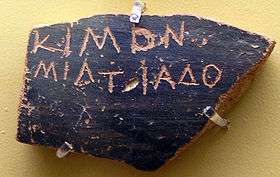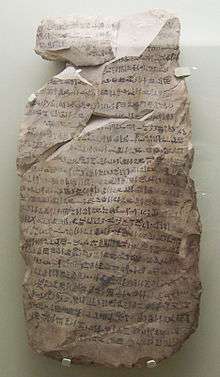Ostracon
_-_Photo_by_Giovanni_Dall'Orto%2C_Nov_9_2009.jpg)

An ostracon (Greek: ὄστρακον ostrakon, plural ὄστρακα ostraka) is a piece of pottery, usually broken off from a vase or other earthenware vessel. In an archaeological or epigraphical context, ostraca refer to sherds or even small pieces of stone that have writing scratched into them. Usually these are considered to have been broken off before the writing was added; ancient people used the cheap, plentiful and durable broken pieces of pottery around them as convenient places to place writing for a wide variety of purposes, mostly very short inscriptions, but in some cases surprisingly long.
Ostracism
In Classical Athens, the voting public would write or scratch the name of a person in the sherd of pottery. When the decision at hand was to banish or exile a certain member of society, citizen peers would cast their vote by writing the name of the person on the piece of pottery; the vote was counted and if unfavorable the person was exiled for a period of ten years from the city, thus giving rise to the term ostracism.
Egyptian limestone and potsherd ostraca

Anything with a smooth surface could be used as a writing surface. Generally discarded material, ostraca were cheap, readily available and therefore frequently used for writings of an ephemeral nature such as messages, prescriptions, receipts, students' exercises and notes: pottery sherds, limestone flakes,[1] thin fragments of other stone types, etc., but limestone sherds, being flaky and of a lighter color, were most common. Ostraca were typically small, covered with just a few words or a small picture drawn in ink;[2] but the tomb of the craftsman Sennedjem at Deir el Medina contained an enormous ostracon inscribed with the Story of Sinuhe.[1]
The importance of ostraca for Egyptology is immense. The combination of their physical nature and the Egyptian climate have preserved texts, from the medical to the mundane, which in other cultures were lost.[3] These can often serve as better witnesses of everyday life than literary treatises preserved in libraries.
Deir el-Medina Medical Ostraca
The many ostraca found at Deir el-Medina provide a deeply compelling view into the medical workings of the New Kingdom. These ostraca have shown that, like other Egyptian communities, the workmen and inhabitants of Deir el-Medina received care through a combination of medical treatment, prayer, and magic.[4] Nevertheless, the records at Deir el-Medina indicates some level of division, as records from the village note both a “physician” who saw patients and prescribed treatments, and a “scorpion charmer” who specialized in magical cures for scorpion stings.[5]
The ostraca from Deir el-Medina also differed in their circulation. Magical spells and remedies were widely distributed among the workmen; there are even several cases of spells being sent from one worker to another, with no “trained” intermediary.[6][7] Written medical texts appear to have been much rarer, however, with only a handful of ostraca containing prescriptions, indicating that the trained physician mixed the more complicated remedies himself. There are also several documents that show the writer sending for medical ingredients, but it is unknown whether these were sent according to a physician’s prescription, or to fulfill a home remedy.[8]
Saqqara Dream Ostraca
From 1964–1971, Bryan Emery excavated at Saqqara in search of Imhotep's tomb; instead, the extensive catacombs of animal mummies were uncovered. Apparently it was a pilgrim site, with as many as 1½ million ibis birds interred (as well as cats, dogs, rams, and lions). This 2nd-century BC site contained extensive pottery debris from the site offerings of the pilgrims.
Emery's excavations uncovered the "Dream Ostraca", created by a scribe named Hor of Sebennytos. A devotee of the god Thoth, he lived adjacent to Thoth's sanctuary at the entrance to the North Catacomb and worked as a "proto-therapist", advising and comforting clients. He transferred his divinely-inspired dreams onto ostraca. The Dream Ostraca are 65 Demotic texts written on pottery and limestone.[9]
Biblical period ostraca
Famous ostraca for Biblical archaeology have been found at:
- Arad, Israel, or Tel Arad
- Lachish
- Mesad Hashavyahu
- Ostraca House at Samaria
- Elah Fortress at Khirbet Qeiyafa[10]
Additionally, the lots drawn at Masada are believed to have been ostraca, and some potsherds resembling the lots have been found.
In October 2008, Israeli archaeologist, Yosef Garfinkel of the Hebrew University of Jerusalem, has discovered what he says to be the earliest known Hebrew text. This text was written on an Ostracon shard; Garfinkel believes this shard dates to the time of King David from the Old Testament, about 3,000 years ago. Carbon dating of the Ostracon and analysis of the pottery have dated the inscription to be about 1,000 years older than the Dead Sea Scrolls. The inscription has yet to be deciphered, however, some words, such as king, slave and judge have been translated. The shard was found about 20 miles southwest of Jerusalem at the Elah Fortress in Khirbet Qeiyafa, the earliest known fortified city of the biblical period of Israel.[10]
New Testament ostraca
Some Christian texts are preserved upon ostraca. In the late 19th century, 20 ostraca were found in Upper Egypt, probably from the 7th century, written in Greek and Coptic.
The ostraca are of different sizes and shapes. The more extant is Luke 22:40-71, which runs over 10 pieces. The ostraca contain from 2 to 9 verses each, and cover Matthew 27:31–32; Mark 5:40-41 (Mark 9:3); Mark 9:17-18, Mark 9:22; Mark 15:21; Luke 12:13-16; Luke 22:40-71; John 1:1-9; John 1:14-17; John 18:19-25; John 19:15-17. There is one ostracon with the inscription "St. Peter the evangelist," perhaps an allusion to the Gospel of Peter.
A Coptic Sa'idic ostracon preserves the Pericope Adulterae found in John 7:53-8:1, which is otherwise omitted in the Sa'idic New Testament. A Christian hymn to Mary, similar to the canticles of Luke, and some Christian letters have also been found.
Christian ostraca
Inscriptions on clay, wood, metal, and other hard materials, like papyri, are valuable especially as the literary sources for Early Christianity. They are found chiefly in Oriental countries (i.e. east of Rome or Southwest Asia), especially Egypt (which though east of Rome is technically North Africa). The greatest number are pieces of clay or scraps of pots inscribed with colors or ink. The oldest Christian ostraca, like the papyri, are Greek and date from the 5th century; next come the Coptic and Arabian ostraca. Some of the texts not yet deciphered include several Nubian ostraca in a language spoken in the old Christian kingdoms in the vicinity of Aloa on the Blue Nile.
In these inscriptions Greek letters are used, with some other signs. As to contents, ostraca are either profane or ecclesiastical. Potsherds were often used for correspondence in place of the less durable papyrus; occasionally the recipient wrote the answer on the back of the potsherd. Ostraca were also used for mercantile purposes, as bills, receipts, etc. C. M. Kaufmann and J. C. Ewald Falls, while excavating the town of Menas in the Libyan desert, discovered ostraca of this class—the oldest Christian potsherds in the Greek language (5th century)—and H. J. Bell and F. G. Kenyon of the British Museum deciphered them.
They refer to the vine-culture of the sanctuaries of Menas and represent, for the most part, short vouchers for money or provisions. The currency is based upon gold solidi issued by Constantine; the date is reckoned by the year of indiction. Of historical interest is the assistance given to invalid workmen, the employment of the lower clergy, the manner of provisioning the workmen, and especially the statements about the harvest periods in the Libyan district. The series of Coptic ostraca which deals with the clergy and the monasteries in the Nile valley is particularly extensive. They refer to all phases of administration and popular life.
The ecclesiastical ostraca, in a narrow sense, contain Biblical citations from the New Testament, prayers, extracts from the synaxaria (lives of the saints), and are partly of a liturgic character. Greek, which was then the language of the Church, is much used, with the Coptic. Among the samples published by W.E. Crum, a fine judge of Coptic dialects, there is a local confession of faith from the 6th century, besides the Preface and Sanctus of the Mass, prayers from the Liturgy of St. Basil and of St. Mark, a part of the didascalia of Schenûte of Athribis, a Greek confession, and an excommunication, also in Greek.
Particularly remarkable are those ostraca which contain liturgical songs. They represent our present song-books for which purpose rolls of papyrus were less suited than the more durable potsherds; in some cases wooden books were used. Among the pieces translated by Crum we find petitions for ordination in which the petitioner promises to learn by heart one of the Gospels, and a reference to an ancient abstinence movement, against which is directed a decree that the consecration-wine should be pure or at least three-fourths pure.
See also
Notes
- 1 2 Donadoni, Sergio, ed. (1997), The Egyptians, Chicago: University of Chicago Press, p. 78, ISBN 0-226-15555-2.
- ↑ Klauck, Hans-Josef (2006), Ancient Letters And the New Testament: A Guide to Context and Exegesis, Baylor University Press, p. 45, ISBN 1-932792-40-6.
- ↑ Chauveau, Michel (2000), Egypt in the Age of Cleopatra: History and Society Under the Ptolemies, Ithaca, NY: Cornell University Press, p. 7, ISBN 0-8014-8576-2.
- ↑ McDowell 2002, p. 53.
- ↑ Janssen, Jac. J. (1980). "Absence from Work by the Necropolis Workmen of Thebes". Studien zur Altägyptischen Kultur. 8: 127–152.
- ↑ Lesko, p. 68
- ↑ McDowell 2002, p. 106.
- ↑ McDowell 2002, p. 57.
- ↑ Reeves (2000).
- 1 2 "Archeologist finds 3,000-year old Hebrew text", CNN, October 30, 2008
References
 This article incorporates text from a publication now in the public domain: Herbermann, Charles, ed. (1913). "Christian Ostraka". Catholic Encyclopedia. New York: Robert Appleton.
This article incorporates text from a publication now in the public domain: Herbermann, Charles, ed. (1913). "Christian Ostraka". Catholic Encyclopedia. New York: Robert Appleton.- Parkinson, Richard; Diffie, W.; Fischer, M.; Simpson, R. S. (1999), Cracking Codes: The Rosetta Stone, and Decipherment, Berkeley: University of California Press, ISBN 0-520-22306-3.
- Reeves, Nicholas (2000), Ancient Egypt: The Great Discoveries: A Year-by-Year Chronicle, London: Thames and Hudson, ISBN 0-500-05105-4. (Specifically, "1964-71: The Sacred Animal Necropolis, Saqqara"; and "1964-65: A Statue Finds Its Face".)
- McDowell, A. G. Village Life in Ancient Egypt: Laundry Lists and Love Songs (Oxford, Oxford University Press, 2002).
- Forsdyke, Sara, Exile, Ostracism, and Democracy: The Politics of Expulsion in Ancient Greece (Princeton, PUP, 2005).
- Litinas, Nikos, Greek Ostraca from Chersonesos, Crete: Ostraca Cretica Chersonesi (O.Cret.Chers.) (Wien: Holzhausen, 2008) (Tyche. Supplementband; 6).
External links
| Wikimedia Commons has media related to Ostraka. |
- Ostraca
- The Ostracon, the research publication of the Egyptian Study Society.
- Archeologist discovers 3000-year old ostracon
- Prize Find: Oldest Hebrew Inscription Biblical Archaeology Review

